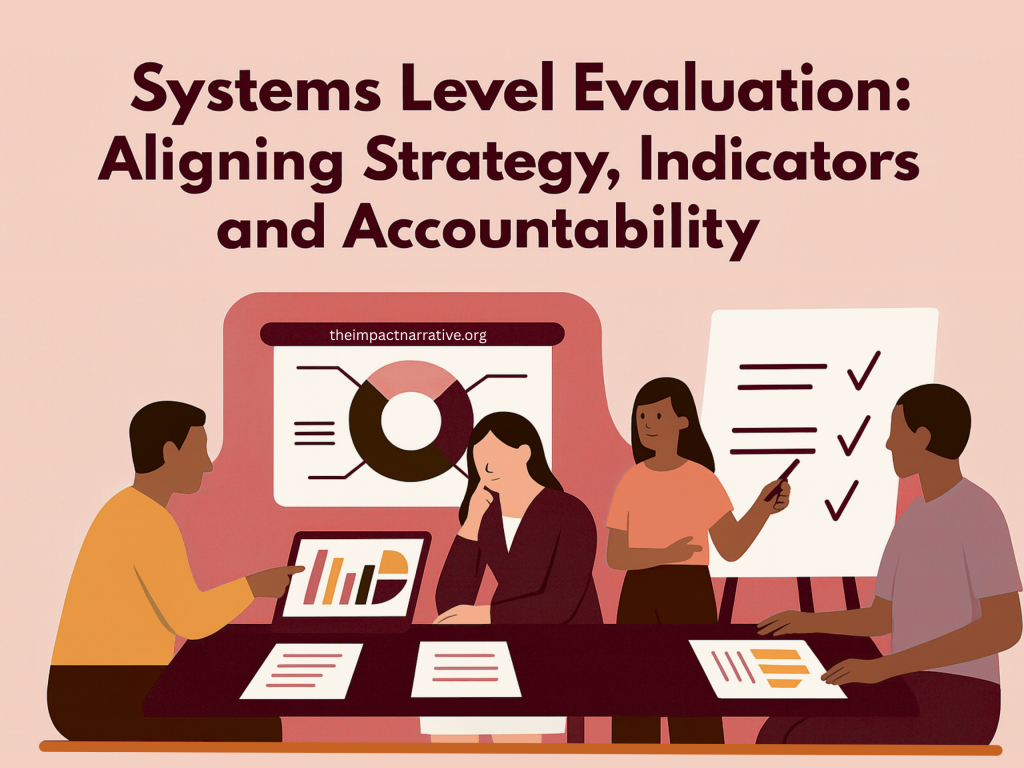Blog
Read stories and case studies from our work at the intersection of strategy, design, and impact. From evaluation insights to community-driven campaigns, we break down how data and storytelling drive better public health outcomes.

Systems Level Evaluation:
Aligning Strategy, Indicators, and Accountability
Outcome evaluation is a vital tool for understanding the effectiveness of public health initiatives and programs, particularly those seeking to drive systemic change. At its core, outcome evaluation answers a fundamental question: Did we achieve what we set out to do? It assesses whether intended outcomes occurred, but importantly, it does not determine what caused them ¹.
In systems-level work, this kind of evaluation becomes more complex. Programs shouldn’t operate in silos, and neither should our evaluation efforts. Effective systems change relies on aligning activities, indicators, and outcomes across multiple levels, organizations, and sectors. A shared theory of change, paired with thoughtful outcome evaluation, can highlight progress and guide decisions across diverse partners.
Connecting the Dots Across the System
The Collective Impact Framework offers a powerful foundation for evaluating systems-level change. The framework emphasizes five core conditions: a common agenda, shared measurement systems, mutually reinforcing activities, continuous communication, and backbone support ². Of these, shared measurement is perhaps the most technically challenging, and most essential, for evaluating collective impact.
Shared measurement allows diverse stakeholders across different sectors to track progress using aligned indicators. These indicators serve as bridges between broad goals, such as improving health outcomes, and measurable metrics, such as the percentage of community residents reporting regular access to behavioral health services. When built into a program logic model or roadmap, indicators can clarify not only what success looks like, but also how specific strategies contribute to achieving it ¹.
Designing Evaluation That Reflect the System
Systems-level evaluation benefits from a clear theory of change that articulates how strategies are expected to lead to change, who is responsible for each component, and what assumptions underlie those strategies. This model acknowledges that no single organization or intervention is responsible for outcomes alone. Instead, outcomes emerge through the combined efforts of many actors operating at different levels of the system.
Evaluation questions should reflect this complexity. Asking, “What are the outcomes, and who contributed to them?” prompts us to examine equity in power, responsibility, and capacity. For example, frontline workers might be expected to generate community-level change, but without organizational investment in training, data systems, and leadership pathways, those outcomes may not materialize. Mapping contributions across system levels helps clarify these dynamics.
Building Capacity for Ongoing Learning
Evaluation should not be a one-time activity, but a process rooted in learning and reflection. Understanding a program’s evaluation capacity, both organizational and individual, is critical. Organizations may have strong internal champions and infrastructure for evaluation, while individuals may bring diverse experiences, expectations, and assumptions about what evaluation is—and isn’t ¹.
Clarifying early on how evaluation differs from performance measurement or research can reduce confusion and help partners engage more fully. Questions like, “Who will use these findings?” and “What decisions will this evaluation inform?” should guide design and implementation from the start
Putting It Into Practice
An excellent example of a systems-level evaluation in action is the C3 Together Evaluation Plan, developed in Mecklenburg County. The plan outlines system-wide goals, multi-level outcomes, and shared indicators that guide data collection and learning across partners. By aligning with the Collective Impact model, the plan supports sustained tracking, accountability, and adaptation over time.
The evaluation plan is structured across three levels: individual, organizational, and systems. It emphasizes shared accountability for shared measurement, ensuring that stakeholders at every level understand their role in advancing collective outcomes and contributing to a cohesive evaluation effort.

The plan takes a tiered approach by organizing evaluation across three levels: individual, organizational, and systems. It emphasizes shared accountability for shared measurement, ensuring that stakeholders at every level understand their role in advancing collective outcomes and contributing to a cohesive evaluation effort.
This structure reinforces several key principles of systems-level evaluation:
- Defined roles across CHWs, organizations, and network partners clarify who is accountable for what.
- Shared responsibility for outcomes ensures collective ownership and aligned action.
- Performance accountability provides a framework for measuring progress across all levels.
Coordinated learning enables continuous improvement and strategy refinement across the system.
Final Thoughts
Systems-level outcome evaluation is not about proving attribution, but about understanding contribution. It asks not only if change is happening, but how and where it is happening, who is responsible, and what can be improved. By aligning strategies, engaging diverse stakeholders, and embracing shared measurement, we create a learning culture capable of advancing collective goals and lasting impact.
Citations
Ready to Align Strategy With Impact?
Impact Narrative Consulting helps public health teams and organizations design outcome-driven evaluation plans grounded in systems thinking, equity, and Collective Impact.

